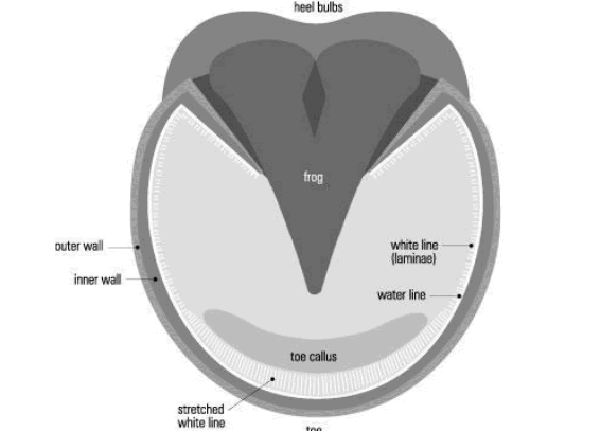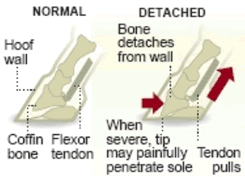Spring has finally arrived and with the warmer weather and the spring showers we can expect a flush of growth in the grass………which means its time to make all horse & pony owners aware of the dangers of Laminitis.
Laminitis is a highly painful and debilitating disease which can occur in the feet of horses and ponies. Laminitis is inflammation of the sensitive structures in the hoof called the lamellae.
The lamellae are the means by which the coffin bone is held tight within the hoof capsule. When viewing the sole of a healthy hoof you can tell how good the connection is by looking at the white line. If the white line is tight (narrow in width) then there is a strong connection. If the white line is stretched then the connection is compromised. Untreated Laminitis can lead to Founder which is where the bone rotates within the hoof capsule and sometimes results in the bone penetrating the sole.

There are many causes of Laminitis, although the most frequent cause in Ireland is believed to be the excessive consumption of lush grass, which is particularly likely in the spring time. Other common causes include excessive feeding of grains, exercising on hard ground and excessive weight bearing following injury to another limb.

SYMPTOMS OF EQUINE LAMINITIS
- Less activity and a reluctance to move when led.
- Lameness – particularly when the horse is circling.
- A faltering gait as though the horse is walking on eggshells.
- Lying down more than is normal to relieve the pain in the feet.
- Shifting weight from one foot to the other.
- Reluctance to turn.
- Standing a typical laminitic stance – hind feet further under the body with weight rocked back and front feet further out in front of the body.
- Tight muscles and heavy sweating.
- Increase in breathing and pulse rate.
- Thick “cresty” neck.
- Hooves warmer than normal.
- Dropped soles or flat feet.
- ‘Bounding’ artery pulses can be felt behind the fetlock in affected legs.
- Pain in toe region when pressure is applied with hoof testers.
- Pain response when pressure is applied to sole.
- Widened white line, known as “seedy toe”. Abscesses may occur.
- Blood in the white line.
- Fever rings visible on hoof wall.
- Curved hooves which are the result of unequal rates of hoof growth.
- Depression, anxiety.

PREVENTION
Laminitis is very painful and debilitating so prevention is very important. This is achieved by first looking at your horse’s lifestyle so that you can identify potential triggers and remove them. If you think your horse/pony may be at risk to getting Laminitis then you could take the following actions:
- Create a bare paddock (with little or no grass) and feed low sugar forage instead such as hay or haylage which has the Laminitis Trust seal of approval.
- Putting on a grazing muzzle allows your horse to be turned out to graze as normal but limits how much grass is consumed.
- Create a track around your field so that the horses have to move more to get their fill.
- Reduce hard feeds and switch to feeds that carry the Laminitis Trust seal of approval such as Speedie Beet and Lo-Cal Balancer (from Baileys Horse Feeds). To learn more about the Laminitis Trust seal of approval, click here.
- Hard feeds/grains should be fed in smaller quantities more often, rather than one big feed.
- Make sure your horse’s feet are trimmed correctly – high heels and long toes are often major contributors to mechanical Laminitis.
If you are in any doubt that your horse/pony may be suffering from Laminitis then contact your vet or farrier immediately.
For a list of vets in Ireland, click here. For a list of farriers in Ireland, click here.
For more handy horse care tips, check out our Welfare Information Section here.
¬

Leave a Reply